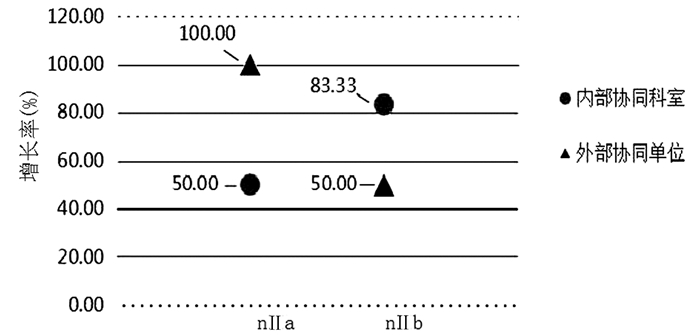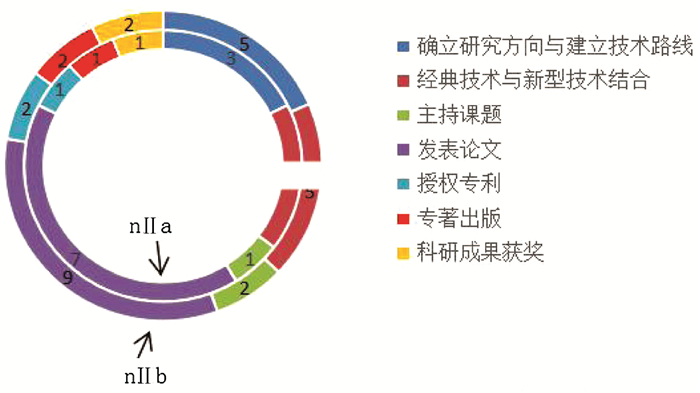协同创新理念下区域性肝脏病理中心科研体系建设的实践与思考
DOI: 10.3969/j.issn.1001-5256.2021.09.031
利益冲突声明:本研究不存在研究者、伦理委员会成员、受试者监护人以及与公开研究成果有关的利益冲突。
作者贡献声明:汤鸿负责课题设计,资料分析,撰写论文;朱颖炜参与收集数据,修改论文;陆忠华负责拟定写作思路,指导撰写文章并最后定稿。
Practice and thinking on constructing a scientific research system for regional liver pathology center under the concept of collaborative innovation
-
摘要:
目的 多角度分析协同创新理念实践对区域性肝脏病理中心科研体系建设的影响,初步探讨其应用意义。 方法 收集2014年1月—2020年9月于无锡市第二人民医院、无锡市第五人民医院病理科检测的1246例肝活检标本,其中区域性肝脏病理中心成立前的为nⅠ组,成立后的为nⅡ组,并将nⅡ组按照成立后第1、2、3年分为nⅡa组、n Ⅱ b组、n Ⅱ c组,以肝活检标本数量、肝活检标本增长率、内部协同科室数量增长率、外部协同单位增长率、协同创新科研体系评价共5项指标进行多角度分析。 结果 n Ⅰ组的肝活检标本增长率为15.51%,组建区域性肝脏病理中心后nⅡa组增长率最高,为187.76%,nⅡb组增长率较稳定,为76.35%;内部协同科室标本量呈现持续性增长,nⅡa组为50%,nⅡb组升高至83.33%,而外部协作单位表现为稳定性增长,nⅡa组为100%,nⅡb组为50%;在科研体系评价指标中nⅡ组呈现多样化增长趋势。 结论 协同创新理念下把握政策支持性发展的机遇,创新内部科室和外部单位的有效协作方式是区域性学科科研体系建设参考的新视角。 Abstract:Objective To investigate the influence of the concept of collaborative innovation on the construction of a scientific research system for regional liver pathology center from multiple perspectives, and to explore its application significance. Methods A total of 1246 liver biopsy specimens which were examined in Department of Pathology in Wuxi Second People's Hospital and Wuxi Fifth People's Hospital from January 2014 to September 2020 were collected, among which the specimens examined before the founding of the regional liver pathology center were collected as nI group, and those examined after the founding of the center were collected as nII group. According to the examination time of the first, second, or third year after founding, the nII group was further divided into nIIa group, nIIb group, and nIIc group. A multi-perspective analysis was performed based on five indices, i.e., number of liver biopsy specimens, growth rate of liver biopsy specimens, growth rate of internal collaborative departments, growth rate of external collaborative units, and evaluation of the collaborative and innovative scientific research system. Results The growth rate of liver biopsy specimens in the nI group was 15.51%; after the founding of the regional liver pathology center, the highest growth rate of 187.76% was observed in the nIIa group, and a relatively stable growth rate of 76.35% was observed in the nIIb group. There was a gradual increase in the number of specimens in internal collaborative departments, with a growth rate of 50% in the nIIa group and 83.33% in the nIIb group, while the number of external collaborative units increased steadily, with a growth rate of 100% in the nIIa group and 50% in the nIIb group. The nII group showed a diversified increasing trend in the evaluation indices of the scientific research system. Conclusion It is a new perspective for the construction of regional disciplinary scientific research system to grasp the opportunity of policy-supported development and innovate the effective cooperation mode between internal departments and external units under the concept of collaborative innovation. -
Key words:
- Liver Diseases /
- Pathology, Clinical /
- Health Services Administration
-
[1] GAO HJ. Practice and thinking on the construction of new clinical medicine discipline of "patient-centered"[J]. Natl Med J China, 2020, 11(40): 3126-3129. DOI: 10.3760/cma.j.cn112137-20200324-00911.郜恒骏. "以患者为中心"新型临床医学学科建设的实践与思考[J]. 中华医学杂志, 2020, 11(40): 3126-3129. DOI: 10.3760/cma.j.cn112137-20200324-00911. [2] VERONICA S, THOMAS F. Collaborative innovation in ubiquitous systems[J]. J Intell Manuf, 2007, 18(5): 599-615. DOI: 10.1007/s10845-007-0064-2. [3] HINRICHS MM, SEAGER TP, TRACY SJ, et al. Innovation in the knowledge age: Implications for collaborative science[J]. Environ Syst Decis, 2017, 37(2): 144-155. DOI: 10.1007/s10669-016-9610-9. [4] van WEEL C, TURNBULL D, WHITEHEAD E, et al. International collaboration in innovating health systems[J]. Ann Fam Med, 2015, 13(1): 86-87. DOI: 10.1370/afm.1751. [5] GOUGET B, TOUIMI B, JELLOUN M. The fifbcml: A mediterranean-leading platform for collaboration and innovation in lab medical[J]. Clin Chem Lab Med, 2017, 55: s131. DOI: 10.1515/cclm-2017-5001. [6] RUAN B, YU Z, YANG S, et al. Establishment and development of national community-based collaborative innovation demonstration areas to achieve the control target of hepatitis B in China[J]. BMC Infect Dis, 2019, 19(1): 617. DOI: 10.1186/s12879-019-4150-9. [7] POYAN MEHR A, SADEGHI-NAJAFABADI M, CHAU K, et al. The glomerular disease study and trial consortium: A grassroots initiative to foster collaboration and innovation[J]. Kidney Int Rep, 2019, 4(1): 20-29. DOI: 10.1016/j.ekir.2018.09.012. [8] BRAY F, FERLAY J, SOERJOMATARAM I, et al. Global cancer statistics 2018: GLOBOCAN estimates of incidence and mortality worldwide for 36 cancers in 185 countries[J]. CA Cancer J Clin, 2018, 68(6): 394-424. DOI: 10.3322/caac.21492. [9] XIAO J, WANG F, WONG NK, et al. Global liver disease burdens and research trends: Analysis from a Chinese perspective[J]. J Hepatol, 2019, 71(1): 212-221. DOI: 10.1016/j.jhep.2019.03.004. [10] TAPPER EB, LOK AS. Use of liver imaging and biopsy in clinical practice[J]. N Eng J Med, 2017, 377(8): 756-768. DOI: 10.1056/NEJMra1610570. [11] TORBENSON M, WASHINGTON K. Pathology of liver disease: Advances in the last 50 years[J]. Hum Pathol, 2020, 95: 78-98. DOI: 10.1016/j.humpath.2019.08.023. [12] TANG H, XU RR, JIANG LL, et al. A study of construction strategy for regional clinical pathology center of liver disease based on SWOT analysis[J]. J Clin Hepatol, 2019, 35(7): 1582-1584. DOI: 10.3969/j.issn.1001-5256.2019.07.031.汤鸿, 徐蓉蓉, 蒋丽琳, 等. 基于SWOT分析法的区域性肝病临床病理研究中心建设策略[J]. 临床肝胆病杂志, 2019, 35(7): 1582-1584. DOI: 10.3969/j.issn.1001-5256.2019.07.031. [13] FU L, YIN L, ZHU ML, et al. Innovation system construction for China's basic and clinical medcine[J]. Eng Sci, 2017, 19(2): 72-78. DOI: 10.15302/J-SSCAE-2017.02.012.付磊, 尹岭, 朱曼璐, 等. 我国基础与临床医学创新体系建设研究[J]. 中国工程科学, 2017, 19(2): 72-78. DOI: 10.15302/J-SSCAE-2017.02.012. [14] ESLAM M, SANYAL AJ, GEORGE J, et al. MAFLD: A consensus-driven proposed nomenclature for metabolic associated fatty liver disease[J]. Gastroenterology, 2020, 158(7): 1999-2014. DOI: 10.1053/j.gastro.2019.11.312. [15] TANAKA N, KIMURA T, FUJIMORI N, et al. Current status, problems, and perspectives of non-alcoholic fatty liver disease research[J]. World J Gastroenterol, 2019, 25(2): 163-177. DOI: 10.3748/wjg.v25.i2.163. [16] LI LJ, ZHENG SS, CHEN Z, et al. Theoretical innovation and technical breakthrough in the diagnosis and treatment of severe liver disease[J]. China Sci Technol Achievements, 2014, 15(1): 64-66. DOI: 10.3772/j.issn.1009-5659.2014.01.025.李兰娟, 郑树森, 陈智, 等. 重症肝病诊治的理论创新与技术突破[J]. 中国科技成果, 2014, 15(1): 64-66. DOI: 10.3772/j.issn.1009-5659.2014.01.025. [17] CHESBROUGH H. Open innovation: Where we've been and where we're going: The father of open innovation offers his assessment of the history and future of the model[J]. Res Technol Manage, 2012, 55(4): 20-27. DOI: 10.5437/08956308X5504085. -



 PDF下载 ( 2332 KB)
PDF下载 ( 2332 KB)


 下载:
下载:




